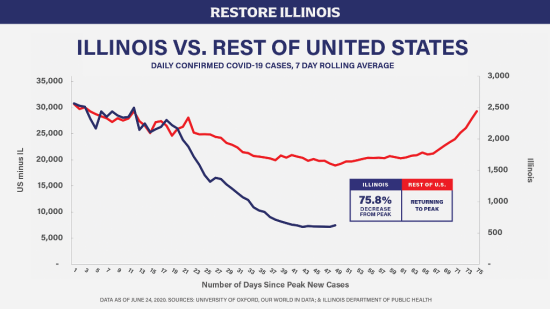|
 “We’ve seen what’s happened in other states that
have allowed politics or short-term thinking to drive
decision-making. Many other states are now seeing significant
increases in cases, hospitalizations, and intensive care bed usage
and they’re being forced to move backward and stay at home – that’s
not the story in Illinois,” said Governor JB Pritzker. “Here, we
have been gradually restoring business and leisure activities in a
highly deliberate manner, guided by doctors’ advice. Illinoisans are
following the mitigations that we can each do ourselves, like
wearing face coverings, keeping 6 feet distance between us, and
washing our hands frequently. It’s because of the people of Illinois
that we’re seeing a trajectory of relative success where other parts
of the country are not.” “We’ve seen what’s happened in other states that
have allowed politics or short-term thinking to drive
decision-making. Many other states are now seeing significant
increases in cases, hospitalizations, and intensive care bed usage
and they’re being forced to move backward and stay at home – that’s
not the story in Illinois,” said Governor JB Pritzker. “Here, we
have been gradually restoring business and leisure activities in a
highly deliberate manner, guided by doctors’ advice. Illinoisans are
following the mitigations that we can each do ourselves, like
wearing face coverings, keeping 6 feet distance between us, and
washing our hands frequently. It’s because of the people of Illinois
that we’re seeing a trajectory of relative success where other parts
of the country are not.”
PHASE 4 METRICS
All four Restore Illinois health regions have met the IDPH health
benchmarks to advance into Phase 4. Metrics include reductions of
positivity rate and hospital admissions and availability of hospital
surge capacity.

On a statewide level, Illinois flattened the curve, passed the peak
and saw a sustained decline in key metrics since the coronavirus
pandemic began. Looking at 7-day rolling averages – which smooth out
daily fluctuations and allow trends to emerge – Illinois is seeing
marked declines in cases, deaths, case positivity and covid-related
hospitalizations.




TESTING & CONTACT TRACING
As all four regions of the state move into Phase 4 of the Restore
Illinois plan on June 26, the state has built up its daily testing
capabilities, surpassing 30,000 tests in a 24 hour period for the
first time today.
[to top of second column] |

Illinois is continuing to build on this progress, launching 12
mobile community testing teams. The testing teams will move
throughout the state to mitigate and suppress emerging outbreaks,
including places like meatpacking plants, nursing homes, or other
traceable gatherings.
The mobile teams will operate in partnership with a network of
commercial labs that the state has contracted with which will allow
test results to be quickly delivered.
The state also continues to build up its statewide contact tracing
capacities, increasing the ranks of contact tracers by 20% since
June 1 for a total of over 550 active contact tracers across the
state. 250 new tracers will join their ranks in the coming weeks as
Illinois continues to scale up operations, including using new
technology to multiply the state’s effectiveness in its contact
tracing efforts.
In addition, all of Illinois’ 97 local health departments have
applied for funding support totaling $230 million to increase
contact tracing. Those funds will be disbursed in the next few
weeks.
Community based organizations will have the opportunity next month
to obtain funding through the Illinois Department of Public Health (IDPH)
to collaborate on contact tracing efforts alongside their local
public health departments.
COUNTY LEVEL RISK METRICS
The state is also launching a new county level risk assessment tool
which will help individuals, families and community groups inform
their choices about personal and family gatherings, as well as what
activities they choose to do.
The county-level indicators are similar to the Restore Illinois
criteria and support the state’s framework. By applying the same
metrics to each county, IDPH is using a standardized approach to
monitor the state as a whole. Each county will be assessed to
determine whether it is meeting or exceeding each indicator target.
Using a color-coded system, counties will be able to determine
whether they are meeting or not meeting set targets.
The Illinois Department of Public Health (IDPH) is monitoring
several indicators that measure the health burden of COVID-19 in
each Illinois county and capture a county’s ability to respond.
These metrics are intended to be used for local level awareness of
each county’s progress during Phase 4 and will help local leaders,
businesses, local health departments, and the public make informed
decisions and promote healthy behaviors.
The state continues to urge all residents to follow the mitigations
that we know will stop or slow down the spread of COVID-19;
maintaining 6 feet of physical distance, hand washing regularly,
and, wearing a face covering.
To view the guidelines for all industries reopening in Phase 4,
visit here.
[Office of the Governor JB Pritzker]
 |